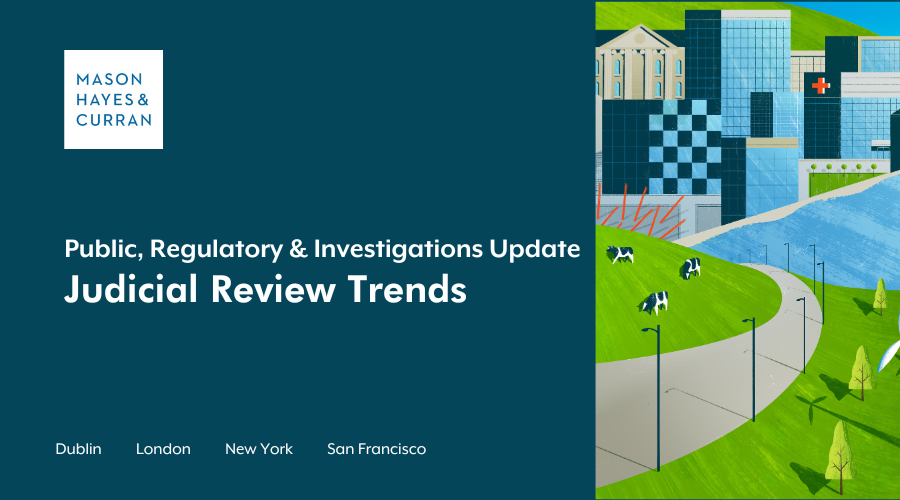
Our Public, Regulatory and Investigations team looks at judicial review trends emerging from the Courts Service Annual Report 2023, published in September 2024. They also examine some recent procedural developments in judicial review proceedings. The trends and developments will be of interest to public bodies dealing with these challenges, and organisations taking them.
What you need to know
- The Courts Service Annual Report 2023 indicates a general increase in judicial review activity.
- The average length of a judicial review case has increased from 208 days in 2022 to 217 days in 2023.
- Wait times for pre-leave applications have decreased slightly, whereas wait times for post-leave applications have increased.
- Recent Supreme Court decisions emphasise that stays should not be granted by default at the leave stage.
- A recent practice change means that when papers are filed, the clock stops for time limit purposes.
Trends from the Annual Report
The Courts Service Annual Report 2023 was published in September 2024 and offers interesting statistics for all cases before the courts. We highlight non-asylum judicial review statistics, which will be of interest to public bodies dealing with these challenges and to organisations pursuing them.
Judicial review (JR) is the legal procedure to challenge the decisions, including acts and omissions, of bodies exercising public functions. If a person believes that a public body’s decision has strayed outside the law or has been made without lawful authority, then that person can seek a review by the High Court.
JR is a two-step process involving:
- An application for leave (that is, permission) to bring the JR proceedings, and
- The substantive hearing itself.
Parties might make applications along the way, such as for a stay on the decision of the public body pending the final determination of the JR proceedings.
The Annual Report indicates that:
- The number of incoming JR applications is on the rise, from 576 in 2022 to 627 in 2023.
- This trend suggests we can expect longer wait times. This is evident from the increase in the average length of proceedings, from 208 days in 2022 to 217 days in 2023.
- Wait times for post-leave applications has also increased slightly, from two months in 2022 to nine weeks in 2023. However, wait times for pre-leave applications has decreased slightly, from seven weeks in 2022 to six weeks in 2023. Applications during the proceedings can therefore be expected to increase the overall length of proceedings.
- The High Court granted leave in fewer cases in 2023 than in 2022 – 191, down from 298. The reduction in the number of cases in which leave was granted might simply be because cases are progressing more slowly due to the Court’s increased caseload, although, it could also suggest a strict application of the test for leave to the cases presenting themselves.
- Conversely, the High Court granted relief in more cases in 2023 than in 2022 – 233, up from 178.
- Interestingly, the number of appeals to the Court of Appeal has increased slightly, with 43 incoming cases in 2023 compared to 38 in 2022.
Procedural developments – stopping the clock
In general, an application for JR must be made within three months of the date on which grounds for JR first arose. The court rules were amended last year (SI 163/2024) so that a judicial review application is ‘made’ when the papers are filed in the Central Office. Prior to this, an applicant would have to open the papers before the Court to stop time running.
Procedural developments – no stays by default at the leave stage
The Supreme Court has made it very clear in recent cases[1] that the practice of granting stays by default when leave is granted should stop. A stay is an order preserving the status quo until the proceedings are finished.
The position reinforced by the Supreme Court is that:
- A JR applicant is not entitled to a stay as of right.
- Public decisions are presumed valid until proved otherwise and this assumption should be given appropriate weight.
- The onus is on the applicant to demonstrate why the test for a stay is met and the respondent should have a chance to be heard.
- Any stay granted at the leave stage should be time-limited and the applicant should have to return to court with the respondent on notice to have the stay continued.
Conclusion
Judicial review activity is on the rise, which suggests an increased appetite for challenging the decisions of bodies exercising public functions. The Courts Service Annual Report indicates that judicial review cases take an average of eight months, although timelines will of course vary depending on the case. However, more judges are proposed to be appointed, which might reduce wait times in the medium term.
Key practice developments for JR applicants and respondents to remember are that:
- The clock stops on the JR time limit when papers are filed, and
- A stay on the decision should not be granted by default where the High Court grants permission to bring the JR case. The onus is on the applicant to make the case for a stay, and the respondent should have a chance to respond.
For more information, contact a member of our Public, Regulatory and Investigations team.
The content of this article is provided for information purposes only and does not constitute legal or other advice.
[1] MD v. Board of Management of A Secondary School [2024] IESC 11; Wen Wei v Minister for Justice and the Commissioner of An Gard Siochana [2024] IESC 58
Share this:




